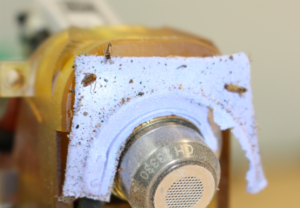
Over the past 18 months, Portable Spectral Services Service Desk has seen a lot of portable XRF (X-ray fluorescence) equipment come through our service desk, often due to avoidable issues. To help you keep your equipment in top shape and avoid costly repairs, we’ve compiled some of the most common problems and how to prevent them.

This is the biggest culprit. Dust, dirt, gravel, leaves, and even insects can sneak into the nose of your XRF instrument. Not only can this gunk mess up your data,
but in worst-case scenarios, it can break delicate components like the beryllium window on the x-ray tube. To avoid this, regularly check and replace
the ultralene window on the nose of the instrument, especially after scanning sharp or abrasive materials. Additionally, when you dig a hole in the ground,
make sure that you aren’t shoveling the displaced dirt directly onto your instrument. (see image 1 and 2).


If you’re performing thousands of scans and letting all that data accumulate on the instrument, it can slow down or even crash the system. The best practice is to back up your data daily to a USB drive. Not only does this keep your instrument running smoothly, but you’ll also end up with a neatly organized USB drive of daily data for your project.
There are no surprises here. Although the S1 TITAN is designed to withstand everyday bumps, it’s still a complex piece of equipment with fragile parts like the 1-micron-thick graphene window of the detector. Always use the wrist strap and remember, your XRF is not a hammer—avoid using it to drive pegs into the ground.


Leaving your XRF inactive for long periods can cause the tube to outgas, leading to material changes and potential failure when you power it back up. To prevent this, turn on your instrument for a few minutes and perform a short scan at least every 1-2 months.
While portable XRF instruments can handle a few splashes, full submersion or extended exposure to moisture is a no-go. Make sure the inside of your transport case is dry before storing your instrument, as a moist environment can cause internal corrosion. And remember, your XRF should never go swimming, even if it’s been an hour since its last meal.
By following these tips, you can keep your portable XRF equipment in great condition and avoid unnecessary repairs. Keep your data backed up, handle your instrument with care, and stay vigilant about maintenance, and your XRF will thank you.

Want to check your XRF’s condition?
Book in your condition report today! A condition report is designed to provide the user with information on the current state of a portable XRF instruments stability, accuracy, precision, software status and physical condition.
Similarly to a car, your instrument needs to be regularly serviced to ensure it is in its best working condition. It is recommended that anyone in possession of a portable XRF have a condition report carried out annually. This is regardless of whether the instrument has been used every day or sitting idle for the year.
All condition reports include;
Email [email protected] for more information.
Author: Zeb Hall, R&D Technician at Portable Spectral Services